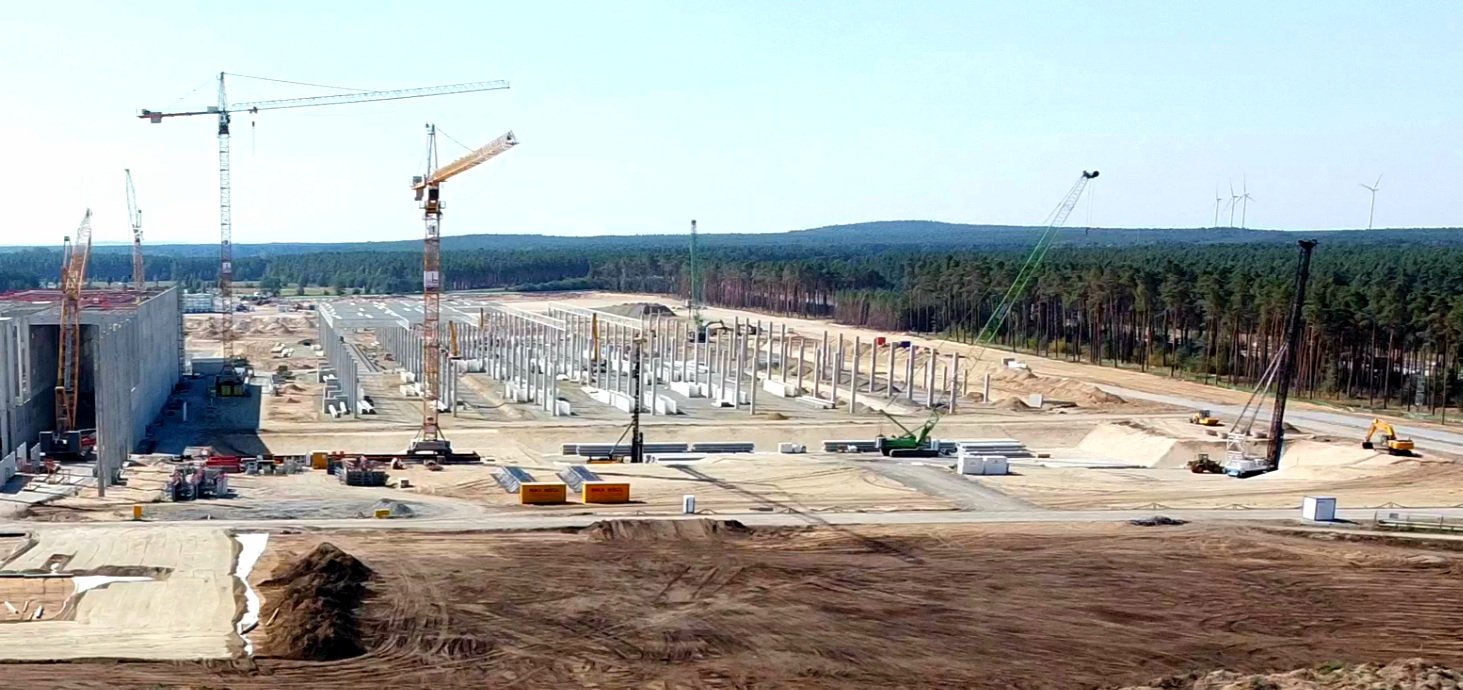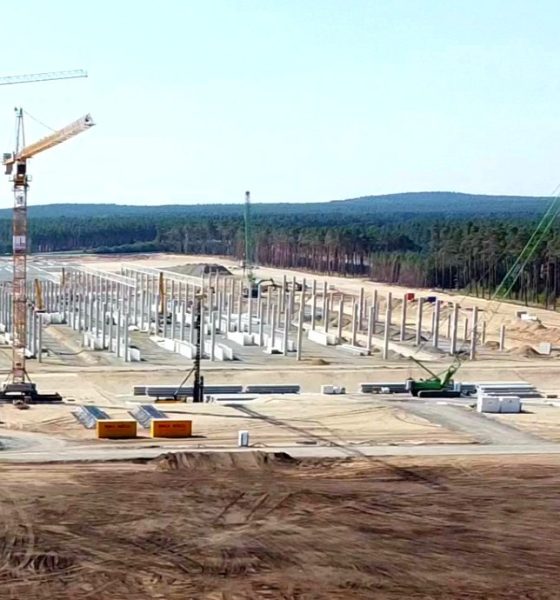

News
Tesla’s software-like approach to its Gigafactories is working wonders in Berlin
If one were to state last year that the pace of Gigafactory Berlin will be faster than the buildout of Gigafactory Shanghai, one would likely have been laughed out of the room. Germany, after all, is not known for incredibly rapid buildouts, as represented by the long delays that have plagued the construction of the now-notorious Berlin Brandenburg Airport (BER). Yet the first phase of Giga Berlin stands today, seemingly poised to meet the hyper-aggressive targets set forth by Elon Musk.
Elon Musk has noted that Gigafactory Berlin could start producing the Model Y as early as next year. That’s an insane target, especially following apparent delays during the GF4 site’s tree-clearing period. Yet once the actual construction of Giga Berlin’s Phase 1 area started, the pace of the whole project changed. And not long after, it became evident that Germany could end up pulling off the impossible: it may very well beat China’s already record-setting pace in building Giga Shanghai.
Part of this lies in Tesla’s utilization of prefabricated materials for Gigafactory Berlin, which allows pre-made sections of the facility to be set up quickly. But this is only part of what makes the practical magic happen in Berlin. As shared recently by industry veteran Alex Voigt, a good part of the reason behind Giga Berlin’s stunning pace is due to Tesla’s software-like approach to the project. Thanks to this approach, the company is able to avoid the usual pitfalls of Germany’s construction initiatives.
Local reports point to the factory shell of Giga Berlin’s drive unit facility possibly being completed in less than three weeks. To meet this target, the Berlin staff reportedly communicate on an everyday basis with the company’s US team. These calls require the US team to be awake at around 3-4 a.m. local time, but Tesla nevertheless ensures that it is reachable by the Germany team during their work hours. Interestingly enough, Elon Musk himself is reportedly present in these calls, allowing him to get a clear outlook of Giga Berlin’s day-to-day progress.
Apart from these, Tesla has reportedly adopted a rather unique permit process for Giga Berlin. Instead of doing all permits at once like in traditional German construction projects, Tesla is reportedly using a system where many permits are requested in small steps, starting with a rough first design and moving on from there. This allows the company to work fast, while providing itself with enough space to adjust if it needs to. Voigt noted that this approach shows Tesla’s Silicon Valley roots, with the company pretty much building Giga Berlin like a software program.
Today, the Gigafactory Berlin site is busy with activity, with prefabricated panels being set up and numerous heavy machinery operating in the area. What’s quite remarkable is that Giga Texas, a facility that will likely be even more expansive than Giga Berlin, is moving at a pace that seems to be even faster than the Germany-based site. Gigafactory Texas was only confirmed less than a month ago, but drone flyovers of the Phase 1 zone in Travis County reveal that a leveled section of the area seems to be getting prepared for ground-breaking. Pile drivers have also been spotted on the Giga Texas site.
Watch a recent flyover of the Gigafactory Berlin site in the video below.
H/T Alex Voigt and @GF4Tesla.

News
Tesla FSD fleet is nearing 7 billion total miles, including 2.5 billion city miles
As can be seen on Tesla’s official FSD webpage, vehicles equipped with the system have now navigated over 6.99 billion miles.

Tesla’s Full Self-Driving (Supervised) fleet is closing in on almost 7 billion total miles driven, as per data posted by the company on its official FSD webpage.
These figures hint at the massive scale of data fueling Tesla’s rapid FSD improvements, which have been quite notable as of late.
FSD mileage milestones
As can be seen on Tesla’s official FSD webpage, vehicles equipped with the system have now navigated over 6.99 billion miles. Tesla owner and avid FSD tester Whole Mars Catalog also shared a screenshot indicating that from the nearly 7 billion miles traveled by the FSD fleet, more than 2.5 billion miles were driven inside cities.
City miles are particularly valuable for complex urban scenarios like unprotected turns, pedestrian interactions, and traffic lights. This is also the difference-maker for FSD, as only complex solutions, such as Waymo’s self-driving taxis, operate similarly on inner-city streets. And even then, incidents such as the San Francisco blackouts have proven challenging for sensor-rich vehicles like Waymos.
Tesla’s data edge
Tesla has a number of advantages in the autonomous vehicle sector, one of which is the size of its fleet and the number of vehicles training FSD on real-world roads. Tesla’s nearly 7 billion FSD miles then allow the company to roll out updates that make its vehicles behave like they are being driven by experienced drivers, even if they are operating on their own.
So notable are Tesla’s improvements to FSD that NVIDIA Director of Robotics Jim Fan, after experiencing FSD v14, noted that the system is the first AI that passes what he described as a “Physical Turing Test.”
“Despite knowing exactly how robot learning works, I still find it magical watching the steering wheel turn by itself. First it feels surreal, next it becomes routine. Then, like the smartphone, taking it away actively hurts. This is how humanity gets rewired and glued to god-like technologies,” Fan wrote in a post on X.
News
Tesla starts showing how FSD will change lives in Europe
Local officials tested the system on narrow country roads and were impressed by FSD’s smooth, human-like driving, with some calling the service a game-changer for everyday life in areas that are far from urban centers.

Tesla has launched Europe’s first public shuttle service using Full Self-Driving (Supervised) in the rural Eifelkreis Bitburg-Prüm region of Germany, demonstrating how the technology can restore independence and mobility for people who struggle with limited transport options.
Local officials tested the system on narrow country roads and were impressed by FSD’s smooth, human-like driving, with some calling the service a game-changer for everyday life in areas that are far from urban centers.
Officials see real impact on rural residents
Arzfeld Mayor Johannes Kuhl and District Administrator Andreas Kruppert personally tested the Tesla shuttle service. This allowed them to see just how well FSD navigated winding lanes and rural roads confidently. Kruppert said, “Autonomous driving sounds like science fiction to many, but we simply see here that it works totally well in rural regions too.” Kuhl, for his part, also noted that FSD “feels like a very experienced driver.”
The pilot complements the area’s “Citizen Bus” program, which provides on-demand rides for elderly residents who can no longer drive themselves. Tesla Europe shared a video of a demonstration of the service, highlighting how FSD gives people their freedom back, even in places where public transport is not as prevalent.
What the Ministry for Economic Affairs and Transport says
Rhineland-Palatinate’s Minister Daniela Schmitt supported the project, praising the collaboration that made this “first of its kind in Europe” possible. As per the ministry, the rural rollout for the service shows FSD’s potential beyond major cities, and it delivers tangible benefits like grocery runs, doctor visits, and social connections for isolated residents.
“Reliable and flexible mobility is especially vital in rural areas. With the launch of a shuttle service using self-driving vehicles (FSD supervised) by Tesla in the Eifelkreis Bitburg-Prüm, an innovative pilot project is now getting underway that complements local community bus services. It is the first project of its kind in Europe.
“The result is a real gain for rural mobility: greater accessibility, more flexibility and tangible benefits for everyday life. A strong signal for innovation, cooperation and future-oriented mobility beyond urban centers,” the ministry wrote in a LinkedIn post.
News
Tesla China quietly posts Robotaxi-related job listing
Tesla China is currently seeking a Low Voltage Electrical Engineer to work on circuit board design for the company’s autonomous vehicles.

Tesla has posted a new job listing in Shanghai explicitly tied to its Robotaxi program, fueling speculation that the company is preparing to launch its dedicated autonomous ride-hailing service in China.
As noted in the listing, Tesla China is currently seeking a Low Voltage Electrical Engineer to work on circuit board design for the company’s autonomous vehicles.
Robotaxi-specific role
The listing, which was shared on social media platform X by industry watcher @tslaming, suggested that Tesla China is looking to fill the role urgently. The job listing itself specifically mentions that the person hired for the role will be working on the Low Voltage Hardware team, which would design the circuit boards that would serve as the nervous system of the Robotaxi.
Key tasks for the role, as indicated in the job listing, include collaboration with PCB layout, firmware, mechanical, program management, and validation teams, among other responsibilities. The role is based in Shanghai.
China Robotaxi launch
China represents a massive potential market for robotaxis, with its dense urban centers and supportive policies in select cities. Tesla has limited permission to roll out FSD in the country, though despite this, its vehicles have been hailed as among the best in the market when it comes to autonomous features. So far, at least, it appears that China supports Tesla’s FSD and Robotaxi rollout.
This was hinted at in November, when Tesla brought the Cybercab to the 8th China International Import Expo (CIIE) in Shanghai, marking the first time that the autonomous two-seater was brought to the Asia-Pacific region. The vehicle, despite not having a release date in China, received a significant amount of interest among the event’s attendees.








